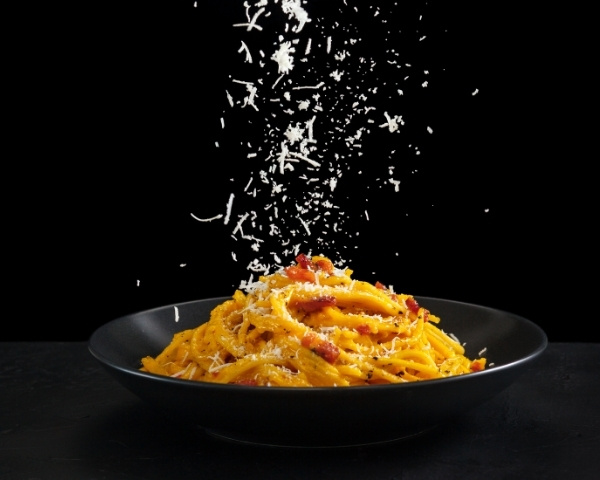Saying “carbonara” is basically saying “Rome” out loud. Just a handful of ingredients – pasta, guanciale (cured pork jowl), Pecorino Romano, eggs, and black pepper -and when it’s done right, everything sings: silky creaminess, the perfume of freshly cracked pepper, and those crispy bites of guanciale. But who actually invented it? That’s where the battles begin: different stories, “my grandpa made it like this,” and heated kitchens. Let’s put things in order—no shortcuts and definitely no cream.
The three main theories (plus one for the romantics)
1) Charcoal burners and hard-working food
The poetic version: “carbonara” as the dish of charcoal makers—people in the woods cooking with what survived the road: dry pasta, aged cheese, eggs, pepper. It smells of campfires and tough jobs. Fascinating and plausible, yes—but without written proof to close the case.
2) Rome, 1944: the Liberation theory
The story many believe: during and after the Liberation of Rome, military rations (eggs—even powdered—and smoked pork cuts) met Roman kitchen smarts. A home-style creamy sauce was born for the soldiers, and within a few years it became a city staple. The first public mentions of “carbonara” show up only in the 1950s: a young recipe, very 20th-century.
3) Rome takes it and makes it Roman
Whatever the spark, the recipe gets disciplined in Rome: guanciale (not pancetta), Pecorino Romano (not “any cheese”), eggs dosed with judgment, and generous black pepper. No garlic, no onion, no cream. The rest is technique: knife work, timing, temperature, and the final toss.
(Bonus) The crowd-pleasing legend
Some tell a near-cinematic tale of an Italian cook and an American GI who, mixing “whatever they had,” served the first carbonara. Is it stamped history? Maybe not. But it explains why this dish speaks perfect Italian… with an international echo.
Why so many “wrong carbonaras” exist
Because carbonara is simple, not easy. The sauce isn’t cream: it’s an emulsion of starchy pasta water, guanciale fat, and Pecorino proteins. Too hot and the eggs scramble; too little starch and the sauce splits; cheese grated too coarsely and it turns grainy.
The most common mistakes
- Cream: convenient, sure—but it muffles the Pecorino and betrays the recipe.
- Pancetta or bacon: different flavor and texture. The right cut is guanciale.
- Garlic or onion: they steal the spotlight. Here, the star is pepper.
- Scrambled egg: a sign you went too hot or too fast.
Golden rule: the less you do, the better it turns out. Let the ingredients speak; you just manage the heat.
Loved in Rome, adopted by the world
In just a few decades, carbonara went from Roman trattorie to menus across the planet. It’s one of the most searched Italian recipes online, a social-media star and TV favorite. Every year on April 6, Carbonara Day lights up feeds with photos, videos, and fiery debates. There are the purists, the re-interpreters, and the first-timers who discover that cream… doesn’t belong. There’s a reason: carbonara is our edible passport—few ingredients, technique, identity.
How to spot the real Roman one (even eyes closed)
- On the nose: well-rendered guanciale (crispy crust, juicy center), fresh pepper, lively Pecorino.
- Look: a smooth, glossy sauce clinging to the pasta; no scrambled bits, no pools of oil.
- Taste: Pecorino’s savoriness, pepper’s gentle heat, the guanciale’s crunch, and a clean finish thanks to a true emulsion. If you don’t want to mop the plate with bread at the end, something’s off.
Our stance (calm but uncompromising)
At Velavevodetto, carbonara is Roman. No cream, no onion, no half-measures. We use properly cut guanciale, render it slowly until crisp and flavorful; Pecorino Romano grated ultra-fine; eggs balanced for a sauce that flows; pepper toasted and ground to order. The final toss is a ritual: off the heat, with just the right pasta water, until the sauce hugs the pasta without breaking.
Want to take a side? Use your fork
The origin debates will go on. Luckily, the plate settles everything. If you want to understand what a true Roman carbonara is, come taste it with us. You’ll find it at our locations in Rome (Testaccio, Prati) and Milan (Duomo, Porta Venezia).
Tip: if you’re making a special trip, give us a call first. We’ll save you a seat—and more importantly, a hot plate.



